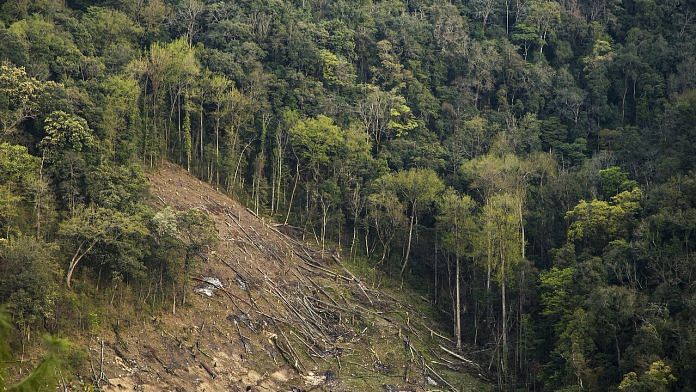The symbiotic relationship between forests and water is vital for creating climate change-resilient agrifood systems. More than half of India’s population works in agriculture and about 50 per cent of them depend on rainfall for water. While agriculture is one of India’s most important socio-economic and land-use sectors, forests provide ecosystem services crucial for agricultural productivity. Now, the ongoing climate crises, receding forest cover, depleting water resources, and soil degradation pose a multifaceted challenge to India’s agrifood systems.
The nexus between forests, water, and agrifood systems is of primary importance for the Food and Agriculture Organization of the United Nations (FAO). The UN’s International Day of Forests and World Water Day, observed on 21 and 22 March respectively, are strong reminders to uphold the important interconnected roles of forests and water, and the need to bring in innovative, collaborative, and comprehensive approaches to work across sectors to advance India’s agrifood systems.
Integrated forest & water resource management
In India, more than 60 per cent of the groundwater is used for irrigation. As a result, depleting groundwater levels, coupled with changing climatic and agroecological conditions, are affecting the agricultural production and livelihoods of smallholder farmers in India.
Forests are integral to maintaining water balance and ecological stability in agricultural landscapes. They mitigate soil erosion, improve soil fertility, and contribute to biodiversity. They also play a pivotal role in water conservation, acting as natural watersheds and reservoirs. The dense canopy of trees helps regulate the hydrological cycle by intercepting rainfall, reducing runoff, and facilitating groundwater recharge, therefore replenishing groundwater sources vital for agricultural activities and strengthening the resilience of agrifood systems to both droughts and floods. The preservation and restoration of forest ecosystems is, therefore, vital to ensure adequate water supply for drinking, irrigation, and other agricultural needs.
The rich biodiversity in forest landscapes contributes to pollination, pest control, and soil fertility. Protecting and restoring forest habitats support biodiversity conservation, which is not only essential for maintaining ecosystem stability and resilience but also providing critical services to agrifood systems through nutrient cycling and environmental stability.
FAO works closely with the Government of India and several state government departments in Chhattisgarh, Haryana, Madhya Pradesh, Mizoram, Odisha, Punjab, Rajasthan, and Uttarakhand on sustainable forest management practices such as afforestation, reforestation, biodiversity conservation, and agroforestry. Agroforestry systems, which integrate trees into agricultural landscapes, have the potential to increase crop yields while conserving water and soil. The adoption of such sustainable practices holds immense potential in enhancing water availability, improving soil health, and advancing climate resilience in India’s agricultural landscapes.
These initiatives are undertaken with funds provided by the Global Environment Facility (GEF). The fund also aligns its efforts to catalyse transformative change in India’s agricultural sector to support the achievement of National and Global Environmental Benefits (GEBs) and conservation of critical biodiversity and forest landscapes in the country.
Also read: India’s pastoral wool producers are being fleeced. Govt must make urgent policy changes
Way forward
India continues to face agricultural challenges due to issues related to land use practices, deforestation, and water management practices. Addressing them requires concerted efforts from policymakers, civil society, and farmers to promote sustainable natural resource utilisation and resilience-building measures.
FAO strongly encourages the conservation and restoration of forest ecosystems, which are critical for the livelihoods and sustenance of forest users and other communities that rely on them. Interventions with a landscape-based approach will address large-scale processes in an integrated and multidisciplinary manner, combining natural resource management with environmental and livelihood considerations.
Innovative and collaborative approaches must be undertaken to improve agroforestry practices and water management to make agriculture sustainable and enhance farmers’ incomes. To help farmers adopt improved agroforestry practices, FAO plans to support the development of standard protocols for raising timber and non-timber agroforestry species, as well as a framework for accreditation of nurseries raising such material.
The Indian government is strongly pushing the digital agriculture agenda by investing in digital infrastructure. FAO is collaborating with key government stakeholders to improve data collection and practices to feed into digital infrastructure that will facilitate policymakers and practitioners in developing interventions to improve the sustainability of agrifood systems, forest conservation and the use of water resources. Such efforts will provide a harmonised indicator for tracking sustainable agriculture under the National Indicator Framework and the Global Indicator Framework for sustainable development goals (SDGs).
FAO seeks to harmonise priorities and investments between India’s agricultural and environmental sectors so that national and global environmental benefits can be fully realised without compromising India’s ability to provide and develop rural livelihoods and meet its food and nutrition security and social (particularly gender) goals.
Recognising and nurturing the symbiotic relationship between forests and water conservation is indispensable for India’s agrarian economy and environmental sustainability. By safeguarding forests as natural water regulators and promoting ecosystem-based approaches, India can mitigate water stress, enhance agricultural productivity, and foster resilience in the face of climate change and advance the UN Agenda 2030.
Takayuki Hagiwara is the UN Food and Agriculture Organization Representative in India. Views are personal.
(Edited by Humra Laeeq)



